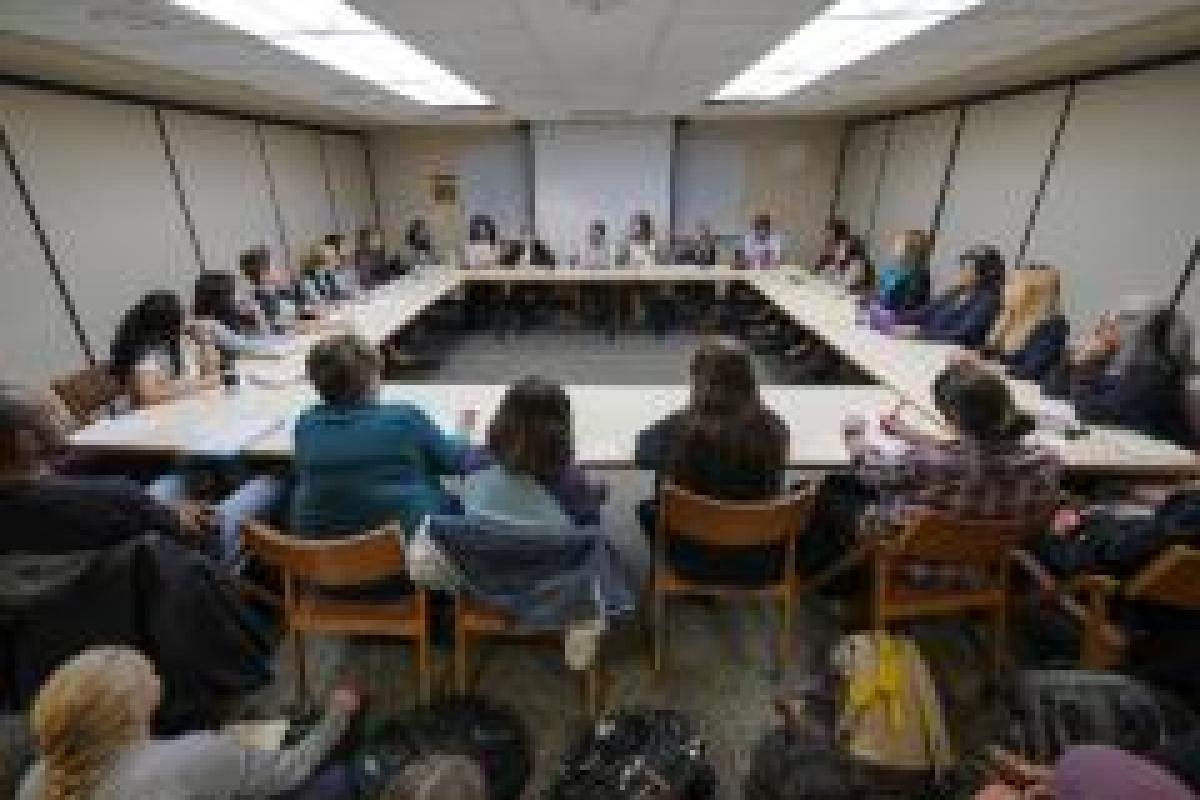Step 4: Equitably Evaluating Candidates
The purpose of this step is to establish clear and consistent criteria for the assessment of candidates' applications and interview responses so as to mitigate implicit and explicit biases in the evaluation process.
It is important to note that Step 4 (Equitably Evaluating Candidates) and Step 5 (Conducting Interviews Inclusively) overlap in the broader faculty-hiring process. Members of the hiring committee and program affiliates who weigh in on faculty-hiring decisions should review Step 4 when assessing candidates at any/every stage of the job search.
In other words, to optimally utilize the Step-by-Step Guide to Inclusive Faculty Hiring, it will be necessary to pan back and forth between Step 4 and Step 5. After all, each stage in the interview phase of the faculty-search process will require strong skills in inclusive and equitable evaluation.
For a detailed breakdown of inclusive evaluative techniques, please consult the four-part guide (Ensuring Equitable Evaluation of Candidates) on the right-hand margin of this page.
Evaluating the Effectiveness of Steps 1-3
Before the hiring committee can begin to evaluate applications, its members must assess whether steps 1-3 of the Step-by-Step Guide to Inclusive Faculty Hiring have indeed generated a broadly representative applicant pool.
As discussed in Step 3 (Advertising the Position to Attract a Diverse Applicant Pool), after the application deadline has passed, the hiring committee must meet with the Affirmative Action Officer in Human Resources to broadly evaluate the demographic composition of the applicant pool and to determine whether benchmarks for specific fields have been met.
If the Affirmative Action Officer's measurement of the applicant pool's diversity does not reflect the unit's commitment to inclusive excellence, the hiring committee must work closely with the Diversity and Inclusive Excellence Unit in Human Resources to reevaluate the strategies it implemented in steps 1 and 3, make adjustments, and extend the application deadline.
When the Affirmative Action Officer's measurement of the applicant pool's diversity meets university standards, the hiring committee should review diversity statements to further assess whether the applicant pool reflects the unit's commitment to inclusive excellence. When the hiring committee is confident in this second measurement of the applicant pool's diversity, its members may begin evaluating applications. It is during the evaluation stage of the hiring process that the committee must take particular care to recognize and counteract structural inequity as well as implicit and explicit biases.
Three Phases of Evaluation
1. Selecting long-list candidates from the entire applicant pool:
The hiring committee alone will select long-list candidates from the initial applicant pool.
Candidates who advance from the initial applicant pool to the long-list pool will proceed to the first round of interviews. Long-list interviews will be conducted through a virtual medium such as an online meeting platform (see Step 5).
2. Selecting short-list candidates from the long-list applicant pool:
The hiring committee will present an abbreviated summary of the long-list pool to the entire faculty. In addition, the hiring committee will present a more detailed profile of each candidate that the hiring committee recommends for the short-list pool. The hiring committee should consider blinding these profiles (please see A Note on Blinding on the right-hand margin of this page) before presenting them to the broader faculty.
Whether or not committee members choose to blind information such as candidates' names when presenting short-list recommendations to their colleagues, the hiring committee should not include photographs or any other information not directly relevant to applicants' qualifications. The hiring committee should also consider blinding for institution (the university from which each potential short-list candidate has graduated) at this phase in the hiring process. The hiring committee will then solicit feedback from the broader faculty before finalizing the short-list candidates.
Candidates who advance from the long-list pool to the short-list pool will participate in site visits (see Step 6), during which time the hiring committee will meet with each candidate for an in-person interview (see Step 5).
3. Selecting the new faculty member from the short-list pool:
Following site visits, the program's entire faculty will select the new hire. Because this stage of evaluation involves program affiliates who are not members of the hiring committee—and because blinding to conceal many aspects of identity and/or group membership is no longer possible—it is imperative that program culture supports the work of diversifying faculty representation. All decisionmakers who have not already done so must read the content in Step 2—paying particular attention to action items 4, 5, and 6—before they can weigh in of hiring decisions.
For more on the importance of equitably evaluating candidates, see these external resources.
Ensuring Equitable Evaluation of Candidates
A Note on Blinding
A Difficult Decision
One way employers have addressed the problem of implicit bias is to implement blinding during evaluation. Blinding entails removing identifying information from an application prior to review. Applicants are then assessed solely on their documented achievements. When hiring bodies are not trained and composed to recognize and mitigate implicit bias, blinding can protect applicants from discrimination. Likewise, when hiring authorities do not have a nuanced understanding of structural inequity, blinding can also prevent tokenization. It is a tool that faculty-hiring committees in the Environmental Studies Program can consider utilizing. But members should be aware of potential pitfalls. If blinding is implemented at the beginning of the search process (e.g. if the hiring committee is blinded), someone who is not on the committee will have to systematically remove identifying information from all applications. This can be time consuming if not impossible. For example, if the hiring committee solicits diversity statements, many applicants will choose to discuss personal information. And, as was mentioned in Step 3, a strong and inclusive hiring committee can use such information—especially that which pertains to adversity—to contextualize applications in which CVs might not adequately reflect applicants' qualifications. In other words, a well-trained and inclusive hiring body can be better equipped to equitably evaluate applications than one that is blinded. The key is in the hiring body's composition and preparation.









